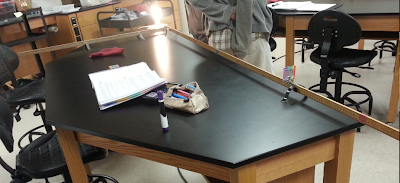Introduction
In this experiment, we measured the wavelength of spectrum that created by white light and colored lights.
Procedure
PART 1. The spectrum of White Light
Experimental set up.
Spectrum observed through grating.
Distance of violet and red band from the light source were measured.
PART 2. Spectra of Hydrogen Gas
Light source is replaced with hydrogen gas tube.
Measure the distance of 4 primary lines of hydrogen spectrum appeared from the light source (Blue, Green, Yellow, and Red)
Data/Discussion
PART 1. Spectrum of White Light
Distance of violet and red band from the white light source, and the wavelength was calculated.
Calibration. The equation was derived by comparing the experimental values and theoretical values.
The violet was closest to the light bulb and red color is the furthest from the light bulb. The color bands were appeared in order of inverse rainbow color: violet, blue, green, yellow, orange, red.
PART 2. Spectra of a Hydrogen Gas
Distance of light bands were measured and wavelength was calculated.
Using the relationship of calibration that obtained from part 1, the adjusted wavelength was obtained.
The % Error was calculated by comparing experimental values to theoretical values. The blue band has 15% error, green band has 21.5% error, yellow band has 25.5% error, and red band has 7.6% error.
Uncertainty of measurement was not considered as a single factor, because the experimental values were averaged 2 or 3 different trials together.
Summary
The spectrum that created by different light source was different in terms of color of bands, width of bands, and number of colors on spectrum. The white light showed continuous rainbow color spectrum while the hydrogen tube showed only 4 colors and very thin bands on its spectrum.























































